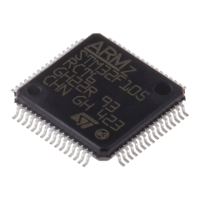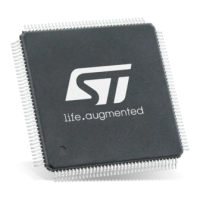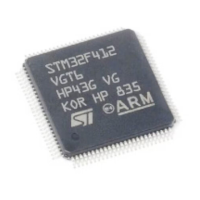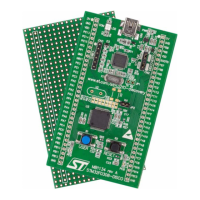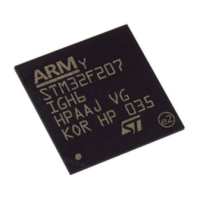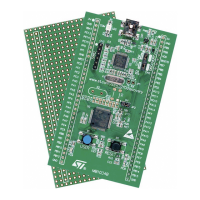RM0008 Universal serial bus full-speed device interface (USB)
Doc ID 13902 Rev 12 607/1096
STAT_RX bits are equal to ‘10 (NAK), any OUT request addressed to that endpoint is
NAKed, indicating a flow control condition: the USB host will retry the transaction until it
succeeds. It is mandatory to execute the sequence of operations in the above mentioned
order to avoid losing the notification of a second OUT transaction addressed to the same
endpoint following immediately the one which triggered the CTR interrupt.
Control transfers
Control transfers are made of a SETUP transaction, followed by zero or more data stages,
all of the same direction, followed by a status stage (a zero-byte transfer in the opposite
direction). SETUP transactions are handled by control endpoints only and are very similar to
OUT ones (data reception) except that the values of DTOG_TX and DTOG_RX bits of the
addressed endpoint registers are set to 1 and 0 respectively, to initialize the control transfer,
and both STAT_TX and STAT_RX are set to ‘10 (NAK) to let software decide if subsequent
transactions must be IN or OUT depending on the SETUP contents. A control endpoint must
check SETUP bit in the USB_EPnR register at each CTR_RX event to distinguish normal
OUT transactions from SETUP ones. A USB device can determine the number and direction
of data stages by interpreting the data transferred in the SETUP stage, and is required to
STALL the transaction in the case of errors. To do so, at all data stages before the last, the
unused direction should be set to STALL, so that, if the host reverses the transfer direction
too soon, it gets a STALL as a status stage. While enabling the last data stage, the opposite
direction should be set to NAK, so that, if the host reverses the transfer direction (to perform
the status stage) immediately, it is kept waiting for the completion of the control operation. If
the control operation completes successfully, the software will change NAK to VALID,
otherwise to STALL. At the same time, if the status stage will be an OUT, the STATUS_OUT
(EP_KIND in the USB_EPnR register) bit should be set, so that an error is generated if a
status transaction is performed with not-zero data. When the status transaction is serviced,
the application clears the STATUS_OUT bit and sets STAT_RX to VALID (to accept a new
command) and STAT_TX to NAK (to delay a possible status stage immediately following the
next setup).
Since the USB specification states that a SETUP packet cannot be answered with a
handshake different from ACK, eventually aborting a previously issued command to start the
new one, the USB logic doesn’t allow a control endpoint to answer with a NAK or STALL
packet to a SETUP token received from the host.
When the STAT_RX bits are set to ‘01 (STALL) or ‘10 (NAK) and a SETUP token is received,
the USB accepts the data, performing the required data transfers and sends back an ACK
handshake. If that endpoint has a previously issued CTR_RX request not yet acknowledged
by the application (i.e. CTR_RX bit is still set from a previously completed reception), the
USB discards the SETUP transaction and does not answer with any handshake packet
regardless of its state, simulating a reception error and forcing the host to send the SETUP
token again. This is done to avoid losing the notification of a SETUP transaction addressed
to the same endpoint immediately following the transaction, which triggered the CTR_RX
interrupt.

